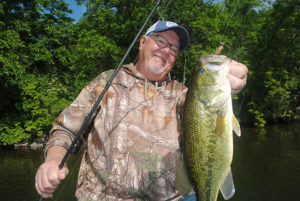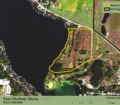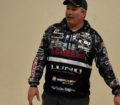By Bob Jensen
Fishing the Midwest Fishing Team

(photo by Bob Jensen) Scott Soderquist with a bass that was on the shallow side of a weedbed.
This time of year, wherever you might be fishing, if that body of water is home to largemouth bass, there will be some bass on the weedline. Here are some ideas for catching those bass.
The weedline can be found in different places. In clear water lakes the weedline will be deeper, ten or twelve feet might be an average weedline depth in lakes that have clear water, but it will be deeper in really clear water. In stained water lakes the weedline might only be five or six feet, and the weeds might be sparser.
Additionally, there will be a shallow or inside weedline and also a deep weedline. A typical weedline might lay out this way: You start out from the shoreline and it’s mostly a sand bottom, but there might be some scattered weeds. Then at say about five feet, the weeds get thicker.
In Midwest waters much of the time the weeds will be cabbage weeds. As the water gets gradually deeper, the weeds usually get thicker. This is the weedbed. As you go deeper, eventually the weed growth will stop. That’s the deep edge of the weedbed, or the weedline.
On cloudy days or early in the day, the bass will be on the shallow edge of the weeds. A spinnerbait buzzed over the tops of the shallow weeds will be productive, but fish the spinnerbait slower if the bass don’t respond. A rubber-legged jig tipped with a Rage Swimmer or Rage Tail Grub will also produce.
In the past several years bass-chasers have learned that swimming a rubber-legged jig tipped with plastic and worked kind of like a spinnerbait is a very good way to catch largemouth bass.
During mid-day, the bass activity will usually be better on the deep weedline. he bass will be scattered along the weedline and grouped on points and pockets on the weedline. As you work along the weedline you’ll find that you can catch one here and another there, but when you come to a point or pocket or some sort of irregularity, you’ll catch several.
There are lots of ways to catch bass along the deep weedline, but it’s hard to beat a crankbait or a jigworm. Fishing guide Mike Frisch likes to employ a 1-2 punch this time of year. He has the angler in the front of the boat throw a crankbait to the weedline. The crankbait will catch the active fish. The angler in the back of the boat casts a jigworm to the weedline in search of the less active bass. It isn’t unusual for the jigworm angler to account for the most action.
Many different species of fish live along the weedline, and although bass might be the target, you’ll probably catch some walleyes or northern pike and every now and then maybe a crappie or a musky. Crankbaits or jigworms will catch all of these. If you want to target bass specifically, try a crankbait with a shorter, fatter body, something like a 5XD or a Series 4, 5, or 6 crankbait. A Lucky Shad crankbait has a longer, thinner body and will be more appealing to a wider variety of gamefish. Experiment with lure colors.
For the jigworm setup, use a sixteenth or eighth ounce jig. When the fish are sluggish, the slower fall of the lighter jigs will get them to bite. When they’re active, you can fish the heavier jigs faster and show the bait to more fish. There are a lot of plastics that will produce, but the go-to for many anglers is a six inch Ocho worm.
Right now is a wonderful time to be on the weedline chasing bass and most other gamefish. Tie on a crankbait or jigworm, position your boat about a cast away from the weedline and start fishing. If you put in a little time, you’re going to get bit.

















